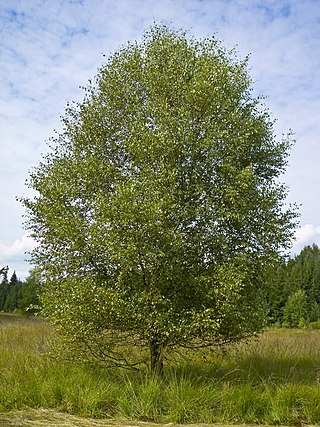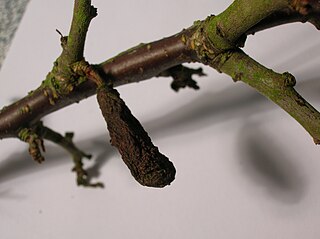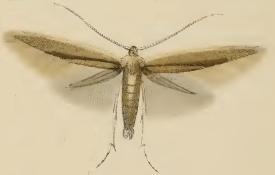
A birch is a thin-leaved deciduous hardwood tree of the genus Betula, in the family Betulaceae, which also includes alders, hazels, and hornbeams. It is closely related to the beech-oak family Fagaceae. The genus Betula contains 30 to 60 known taxa of which 11 are on the IUCN 2011 Red List of Threatened Species. They are a typically rather short-lived pioneer species widespread in the Northern Hemisphere, particularly in northern areas of temperate climates and in boreal climates.

Alnus glutinosa, the common alder, black alder, European alder, European black alder, or just alder, is a species of tree in the family Betulaceae, native to most of Europe, southwest Asia and northern Africa. It thrives in wet locations where its association with the bacterium Frankia alni enables it to grow in poor quality soils. It is a medium-sized, short-lived tree growing to a height of up to 30 metres (98 feet). It has short-stalked rounded leaves and separate male and female flowers in the form of catkins. The small, rounded fruits are cone-like and the seeds are dispersed by wind and water.

Betula pendula, commonly known as silver birch, warty birch, European white birch, or East Asian white birch, is a species of tree in the family Betulaceae, native to Europe and parts of Asia, though in southern Europe, it is only found at higher altitudes. Its range extends into Siberia, China, and southwest Asia in the mountains of northern Turkey, the Caucasus, and northern Iran. It has been introduced into North America, where it is known as the European white birch or weeping birch and is considered invasive in some states in the United States and parts of Canada. The tree can also be found in more temperate regions of Australia.

Betula pubescens, commonly known as downy birch and also as moor birch, white birch, European white birch or hairy birch, is a species of deciduous tree, native and abundant throughout northern Europe and northern Asia, growing farther north than any other broadleaf tree. It is closely related to, and often confused with, the silver birch, but grows in wetter places with heavier soils and poorer drainage; smaller trees can also be confused with the dwarf birch.

Fomitopsis betulina, commonly known as the birch polypore, birch bracket, or razor strop, is a common bracket fungus and, as the name suggests, grows almost exclusively on birch trees. The brackets burst out from the bark of the tree, and these fruit bodies can last for more than a year.

Taphrina is a fungal genus within the Ascomycota that causes leaf and catkin curl diseases and witch's brooms of certain flowering plants. One of the more commonly observed species causes peach leaf curl. Taphrina typically grow as yeasts during one phase of their life cycles, then infect plant tissues in which typical hyphae are formed, and ultimately they form a naked layer of asci on the deformed, often brightly pigmented surfaces of their hosts. No discrete fruit body is formed outside of the gall-like or blister-like tissues of the hosts. The asci form a layer lacking paraphyses, and they lack croziers. The ascospores frequently bud into multiple yeast cells within the asci. Phylogenetically, Taphrina is a member of a basal group within the Ascomycota, and type genus for the subphylum Taphrinomycotina, the class Taphrinomycetes, and order Taphrinales.

Eriocrania sangii, the large birch purple, is a moth of the family Eriocraniidae found in Europe and described by John Henry Wood in 1891. The moth can be found flying in sunshine around birch trees and the larvae feed on birch leaves.

Eriocrania unimaculella is a moth of the family Eriocraniidae found in Europe. It was first described by the Swedish naturalist Johan Wilhelm Zetterstedt in 1839. The larvae feed inside the leaves of birch, making a mine.

Taphrina pruni is a fungal plant pathogen of blackthorn that causes the pocket or bladder plum gall, a chemically induced distortion of the fruit (sloes), producing swollen on one side, otherwise deformed and flattened fruit gall without a stone. The twigs on infected plants may also be deformed with small strap-shaped leaves.

Stigmella lapponica is a moth of the family Nepticulidae found in Asia, Europe and North America. It was first described by the German entomologist, Maximilian Ferdinand Wocke in 1862. The larvae mine the leaves of birch.

Taphrina padi is a fungal plant pathogen that induces the form of pocket plum gall that occurs on bird cherry. The gall is a chemically induced distortion of the fruits, which are swollen, hollow, curved and greatly elongated, without a seed or stone, but retaining the style. The twigs on infected plants may also be deformed with small strap-shaped leaves.

Coleophora milvipennis is a moth of the family Coleophoridae. It is found in all of Europe, east to Japan (Hokkaido).

Euceraphis punctipennis, the downy birch aphid or European birch aphid, is a species of aphid in the order Hemiptera. These aphids are tiny green insects with soft bodies and membranous wings. They are found living on downy birch trees where they feed and multiply on the buds and leaves by sucking sap.

Acalitus brevitarsus is an eriophyid mite which induces domed, blister like swellings, known as galls, on some species of alder.

Andricus inflator is a species of gall-forming wasps, in the genus Andricus, which has a sexual and an asexual generation, producing two different galls. The wasp was named by the German biologist Theodor Hartig, in 1840 and is found in Europe.

Taphrina tosquinetii is a fungal plant pathogen that causes large blisters on both surfaces of the leaves of alder.
Acalitus stenaspis is an eriophyid mite which causes galls on beech. It is found in Europe and was first described by the Austrian zoologist Alfred Nalepa in 1891.
Acalitus calycophthirus is an eriophyid mite which causes big bud galls on birch twigs. It is found in Europe and was first described by the Austrian zoologist, Alfred Nalepa in 1891.
Massalongia rubra is a species of gall midge which forms galls in the leaves of birch. It was first described by the French naturalist and entomologist, Jean-Jacques Kieffer in 1890 and is found in Europe.
















